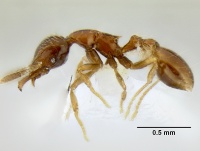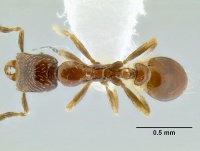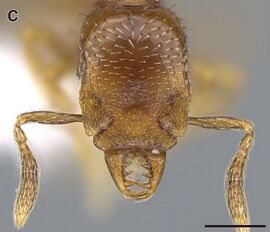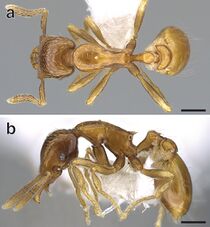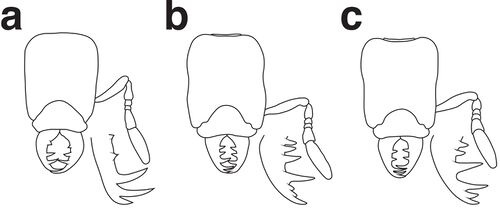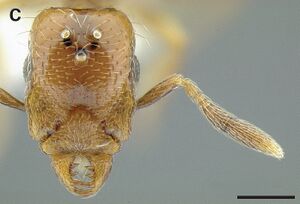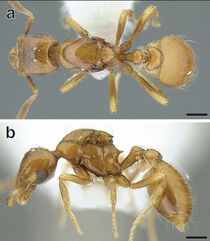Strumigenys nitens
| Strumigenys nitens | |
|---|---|

| |
| Scientific classification | |
| Kingdom: | Animalia |
| Phylum: | Arthropoda |
| Class: | Insecta |
| Order: | Hymenoptera |
| Family: | Formicidae |
| Subfamily: | Myrmicinae |
| Tribe: | Attini |
| Genus: | Strumigenys |
| Species group: | nitens |
| Species: | S. nitens |
| Binomial name | |
| Strumigenys nitens Santschi, 1932 | |
The only species of the Caribbean Strumigenys nitens species group that is not endemic to a single island. Strumigenys nitens is recorded from Cuba and the Bahamas, which expands the northern range of the group. Like all the species in this group, it is only known from a small number of specimens. This limits our understanding of within-species variation thus leaving open the possibility these occurrences represent two different species.
Identification
Booher et al. (2019) – Strumigenys nitens can be distinguished from other congeners in the nitens group, except for Strumigenys hubbewatyorum, by the dental count of five + two intercalary denticles. This species is most closely related to S. hubbewatyorum but can be distinguished from it by lighter coloration (S. nitens is orange to light yellowish brown and S. hubbewatyorum is dark brown), absence of elongate differentiated setae on vertices of their cephalic margin (two elongate filiform to subflagellate erect and differentiated setae present in S. hubbewatyorum), short decumbent ground pilosity on mesosoma (shorter than eye width and simple in S. nitens and longer than eye width and wavy ground pilosity in S. hubbewatyorum), smaller size, and shorter femur (WL = 0.51-0.56 HL = 0.47-0.50 FL = 0.27-0.36 vs. S. hubbewatyorum WL = 0.57-0.62, HL = 0.52-0.53, FL = 0.39-0.42). This species is also closely related to Strumigenys caiman, but can be distinguished from it by the following additional characters: inner mandibular margin with three teeth; apex of mandibles with two teeth and two intercalary denticles vertically arranged: the uppermost is spiniform, followed by two small intercalary denticles that appear to arise from the margin of the lowermost tooth, which is elongate-triangular (see Fig. 2b in Caste section); mandibles shorter (MI 31-33 vs. 38-39 in S. caiman); antennal scape is longer (SI 61-74 vs. 56-60); mesosoma slightly more elongate (WL 2.3 times PW vs. 2.1-2.2); eye larger, diameter greater than the maximum width of the antennal scape. The following characters separate S. nitens from Strumigenys zemi and Strumigenys convexiceps: mandibles relatively long (MI 24-29 in S. zemi and S. convexiceps) petiolar node narrow in dorsal view, about half the width of the postpetiole; mesosoma relatively elongate (WL 1.7-1.8 times PW in S. zemi and S. convexiceps).
Keys including this Species
Distribution
Latitudinal Distribution Pattern
Latitudinal Range: 24.9052° to 20.46666667°.
| North Temperate |
North Subtropical |
Tropical | South Subtropical |
South Temperate |
- Source: AntMaps
Distribution based on Regional Taxon Lists
Neotropical Region: Bahamas, Cuba (type locality), Greater Antilles.
Distribution based on AntMaps
Distribution based on AntWeb specimens
Check data from AntWeb
Countries Occupied
| Number of countries occupied by this species based on AntWiki Regional Taxon Lists. In general, fewer countries occupied indicates a narrower range, while more countries indicates a more widespread species. |

|
Estimated Abundance
| Relative abundance based on number of AntMaps records per species (this species within the purple bar). Fewer records (to the left) indicates a less abundant/encountered species while more records (to the right) indicates more abundant/encountered species. |

|
Biology
Booher et al. (2019) – The lost type of S. nitens was collected from Sierra del Rosario, located in present-day Artemisia province, which reaches an elevation of 450 meters. Other specimens have been collected in Pinar del Rio province in Valle Viñales National Park from lowland tropical moist forest, and from lowland tropical rainforest in Holguín province. In both of the latter localities, specimens were collected from leaf litter extracted via the Winkler method. The single specimen collected on North Andros Island is also from a low elevation habitat and generally matches S. nitens as described here. It does differ slightly in having a pair of elongate pronotal setae and is smaller than any of the other S. nitens we examined. However, without additional material to determine the stability of size and pilosity characters that differ slightly from the Cuban S. nitens material, we conservatively identify this specimen as a worker of S. nitens.
Castes
Worker
Queen
Nomenclature
The following information is derived from Barry Bolton's Online Catalogue of the Ants of the World.
- nitens. Strumigenys (Codiomyrmex) nitens Santschi, 1932e: 413, fig. 2 (w.) CUBA. Combination in Codiomyrmex Weber, 1934a: 52; in Dorisidris: Brown, 1948e: 116; in Pyramica: Bolton, 1999: 1672; in Strumigenys: Baroni Urbani & De Andrade, 2007: 125. See also: Bolton, 2000: 208.
Unless otherwise noted the text for the remainder of this section is reported from the publication that includes the original description.
Booher et al. (2019) – The type of S. nitens is missing from its mount at NHMB, so we rely on Santschi’s original description of the species as a guide to designate a neotype. Bolton (2000) redescribed S. nitens from specimens collected during later expeditions (Strumigenys caiman in the present study), but his description was at odds with the original description (Santschi 1932), specifically where dental count is concerned: Santschi noted that the total dental count was five, with two short teeth along the inner margin of the mandible and three teeth apically (the upper two long, and the lower one shorter). An illustration of the mandibles in full face view an oblique antero-dorsal view accompanied the description (reproduced in Fig. 2a, see Caste section). It appears that the third tooth from the base, or uppermost apical tooth, is shifted toward the base, away from the mandibular apex. This matches the specimens that we describe as S. nitens, but not those of S. caiman, where the third tooth from the base is shifted forward, in line with the three other apical teeth when in full-face view (Fig. 2c, see Caste section). Additionally, in S. nitens, the diastema between the lower teeth at the mandibular apex is interrupted by two minute intercalary denticles (Fig. 2b, see Caste section), which may have been overlooked by Santschi (1932).
Description
Worker
Booher et al. (2019) – Neotype: HL = 0.47; HW = 0.36; ML = 0.16; PW = 0.23; SL = 0.23; FL 0.33; CT = 0.30; EL = 0.06; TL = 2.02; WL = 0.52; CI = 77; MI = 33; SI = 62. Non-types (n=6): HL = 0.43-0.50 (0.48); HW = 0.32-0.38 (0.36); ML = 0.13-0.16 (0.15); PW = 0.22-0.25 (0.23); SL = 0.19-0.24 (0.22); FL = 0.27-0.36 (0.34); CT = 0.28-0.32 (0.3); EL = 0.06-0.07 (0.07); TL = 1.84-2.19 (2.06); WL = 0.44-0.56 (0.53); CI = 74-78 (75); MI = 30-33 (32); SI = 59-68 (61).
Mandibles in full face view and at full closure elongate-triangular, strongly tapering apically, and longer than the apical antennal segment in full face view; MI 30-33. Distalmost third tooth of the inner mandibular margin and extreme apices of mandibles engage, and a broad subovate gap is present between them through which the broad labral lobes are visible. Inner mandibular margin with two conical teeth whose apices are widely separated in addition to a third elongate-triangular tooth whose apices touch at full closure; the first about one-quarter of the margin length from the base, the second about one-half way along the margin, and the third at three-quarters the way along the margin. Apex of mandibles two teeth arranged vertically, with the upper long and spiniform and the lower elongate-triangular; two intercalary denticles arise between these apical teeth along the margin of the apicoventral tooth (Fig. 2b, see Caste section). Clypeus and upper scrobe margins have fine faint longitudinal striolate-punctate sculpture, traces of which are also present on the cephalic dorsum between the frontal carinae. Antennal scapes long: SI 58-68. Lateral margins of the head roughly parallel and the posterior margin shallowly concave in full-face view. Dorsum of head with elongate, spatulate setae which curve toward the midline. Scrobal margin with a single pair of short slightly expanded hairs at apicoscrobal position. Compound eye large: diameter greater than to the maximum width of the antennal scape. In profile view, faint punctate sculpture present between the compound eye and the postbuccal impression.
Mesosoma elongate: WL 2.3 times PW. Uniformly smooth and shining, with faint traces of sculpture around the propodeal spiracle and lamellae. Dorsal surface with elongate, spatulate setae which curve toward the midline.
Petiolar node narrow, roughly 1/2 as broad as postpetiole in dorsal view. Petiolar peduncle covered in light punctate sculpture, but dorsal surface of petiole and postpetiole smooth and shining. Dorsal surfaces of petiole and postpetiole with elongate, spatulate setae.
Basigastral costulae present only on the limbus and the extreme base of the first gastral tergite, the remainder of which is smooth and shining. First gastral tergite with numerous long, fine, tapering setae.
Head, mesosoma, gaster, and appendages uniformly light reddish or yellowish brown.
Type Material
Booher et al. (2019) – Strumigenys nitens Santschi 1932: 413, fig. 2. Neotype worker: CUBA: Holguín: 2km N La Melba, 20° 28´ N, 74° 49´ W, 400 m, 22.viii.2001, P. S. Ward#14424-5, sifted litter (leaf mold, rotten wood), rainforest (CASENT0106246 / MCZ-ENT00681484) [MCZC].
Lost type, as noted by Bolton (2000) - Specimen missing from mount, observed July, 1996. Holotype worker, CUBA: Province de Pinar del Rio, Sierra del Rosario, 17.xi.1931 (A. Bierig) (Naturhistorisches Museum, Basel).
References
- Baroni Urbani, C. & De Andrade, M.L. 2007. The ant tribe Dacetini: limits and constituent genera, with descriptions of new species. Annali del Museo Civico di Storia Naturale “G. Doria” 99: 1-191.
- Bolton, B. 1999. Ant genera of the tribe Dacetonini (Hymenoptera: Formicidae). J. Nat. Hist. 3 33: 1639-1689 (page 1672, Combination in Pyramica)
- Bolton, B. 2000. The ant tribe Dacetini. Memoirs of the American Entomological Institute. 65:1-1028. (page 208, figs. 144, 184 redescription of worker)
- Booher, D.B., Prebus, M.M., Lubertazzi, D. 2019. A taxonomic revision of the Strumigenys nitens and simulans groups (Hymenoptera: Formicidae), two Caribbean radiations of leaf litter ants. Zootaxa. 4656, 335-358. doi:10.11646/zootaxa.4656.2.7
- Brown, W. L., Jr. 1948e. A preliminary generic revision of the higher Dacetini (Hymenoptera: Formicidae). Trans. Am. Entomol. Soc. 74: 101-129 (page 116, Combination in Dorisidris)
- Santschi, F. 1932g. Quelques fourmis inédites de l'Amérique centrale et Cuba. Rev. Entomol. (Rio J.) 2: 410-414 (page 413, fig. 2 worker described)
- Weber, N. A. 1934a. Notes on neotropical ants, including the descriptions of new forms. Rev. Entomol. (Rio J.) 4: 22-59 (page 52, Combination in Codiomyrmex)
References based on Global Ant Biodiversity Informatics
- Alayo D. P. 1974. Introduccion al estudio de los Himenopteros de Cuba. Superfamilia Formicoidea. Academia de Ciencias de Cuba. Instituto de Zoologia. Serie Biologica no.53: 58 pp. La Habana.
- Bolton B. 1999. Ant genera of the tribe Dacetonini (Hymenoptera: Formicidae). Journal of Natural History 33: 1639-1689.
- Bolton, B. 2000. The Ant Tribe Dacetini. Memoirs of the American Entomological Institute 65
- Booher D. B., M. M. Prebus, and D. Lubertazzi. 2019. A taxonomic revision of the Strumigenys nitens and simulans groups (Hymenoptera: Formicidae), two Caribbean radiations of leaf litter ants. Zootaxa 4656: 335-358.
- Brown W. L., Jr. 1950. Revision of the ant tribe Dacetini: II. Glamyromyrmex Wheeler and closely related small genera. Trans. Am. Entomol. Soc. 76: 27-36.
- Deyrup M. 1997. Dacetine ants of the Bahamas (Hymenoptera: Formicidae). Bahamas Journal of Science 5(1): 2-6.
- Deyrup M., L. Davis, and S. Buckner. 1998. Composition of the ant fauna of three Bahamian islands. Proceedings of the seventh symposium on the natural history of the Bahamas. 23-32. Bahamian Field Station, San Salvador, Bahamas
- Fontanla Rizo J.L. 1997. Lista preliminar de las hormigas de Cuba. Cocuyo 6: 18-21.
- Fontenla J. L., and J. Alfonso-Simonetti. 2018. Classification of Cuban ants (Hymenoptera: Formicidae) into functional groups. Poeyana Revista Cubana de Zoologia 506: 21-30.
- Fontenla Rizo J. L. 1997. Lista preliminar de las hormigas de Cuba (Hymenoptera: Formicidae). Cocuyo 6: 18-21.
- Kempf, W.W. 1972. Catalago abreviado das formigas da regiao Neotropical (Hym. Formicidae) Studia Entomologica 15(1-4).
- Portuondo E. F., and J. L. Reyes. 2002. Mirmecofauna de los macizos montañosos de Sierra Maestra y Nipe-Sagua-Baracoa. Cocuyo 12: 10-13
- Portuondo Ferrer, E. and J. Fernandez Triana. Biodiversidad del orden Hymenoptera en Los Macizos Montanosos de Cuba Oriental. Boletin S.E.A. 35:121-136.
- Reyes, J. L. "Inventario de la colección de hormigas (Hymenoptera: Formicidae) del Centro Oriental de Ecosistemas y Biodiversidad, Santiago de Cuba, Cuba." Boletín de la Sociedad Aragonesa 36 (2005): 279-283.
- Santschi F. 1932. Quelques fourmis inédites de l'Amérique centrale et Cuba. Revista de Entomologia (Rio de Janeiro). 2: 410-414.
